Brass Foundry Souvenirs
(c) Antique Metalware Society
Small extracts can be used with acknowledgements to 'Oldcopper.org' website.
Helpful comments are very welcome.
Traditional brass foundries would cast their products by pouring molten brass to solidify to shape in sand moulds with each shape needing its own wooden pattern. Once made and used for the first time, patterns were identified and kept in store in the pattern loft as carefully as might be until needed again. After being cast and knocked out of the sand, items were usually ‘fettled’ by cutting off the runners, risers and breathers that had let the liquid metal in uniformly and the air out accordingly and dressing the surface as needed. Most castings then needed to me machined to some extent to ensure that faces would mate with assembled components and were also frequently drilled and tapped for securing screws. A decision to make a celebration souvenir would call up top skills to supplement normal procedures.
The pattern had to be made very carefully and finished to a perfect surface finish. The casting surface had to be excellent on all faces so use of the finest grade of moulding sand was essential. If wording was to be inserted in the casting, it had to be very carefully moulded. The design usually required a demonstration of foundry skills such that very little fettling was to be used. If the surface finish of a souvenir was slightly defective and needed attention it was more likely to be scrapped rather than rectified.
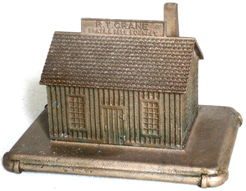
1228 This superb sand cast brass reproduction of a wooden office hut is in two parts, the base and the hut itself. The casting technique for the hut is intricate because of the presence of re-entrant features that mean that it was not a simple two-part mould. There are various ways in which this could have been made but clues are covered by a coating of a lasting matt brass finish. The separate base has edging representing pipes with corner bends and is secured to the hut by two screws. The top notice board reads, in relief, ‘R T Crane, Brass and Bell Foundry’ and the base has an impression reading ‘1855 Crane Co 1925’. Height approx 66mm (2⅝”). The company was formed by Richard and Charles Crane in Chicago as R T Crane & Bro. By 1930 they were at Crane Building, 836 South Michigan Avenue, Chicago, Illinois and had manufacturing plants for cast brass valves, plumbing supplies and other products at Chicago, Bridgeport, Birmingham, Chattanooga, Trenton and North Tonawanda, N.Y.
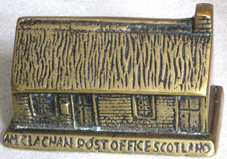
7026 On a similar but simpler theme is this cast brass souvenir from the 1938 Empire Exhibition held in Glasgow. It is well made a replica of the Post Office House in Clachan, North Uist, Scotland by a skilled founder. It appears to be a one-piece casting with an open interior showing a central vertical mould parting line. The ends are left well fettled and smooth. Height approx 44mm (1¾”).
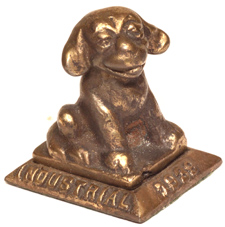
1209 A paperweight commemorating 'Industrial Outing 1939' in the form of a dog of spaniel-like appearance screwed to a rectangular base with iron weighting and a green baize under-surface. Intriguingly, there is no mention of the name of the industry, hopefully it can be recognised? American, 58 x 50 x 67mm high. Weight 370g.
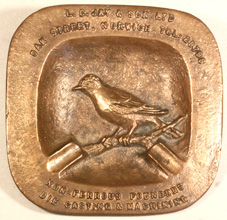
782 A striking central bird motif showing a jay in the centre of a cast brass ashtray was perhaps an obvious but excellent choice made by brassfounders L. C. Jay and Son Ltd., still working in Oak Street, Norwich. It is 125mm (5”) square.
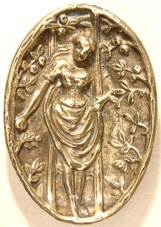
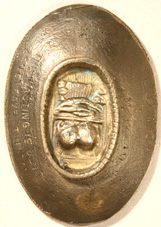
7899 The Autumnal design of the rectangular tray shows a female gardener wearing a headscarf and navigating a pile of leaves with her wheelbarrow forming a high relief foreground together with its handles, a spade and hazel broom. In the background is a tree and a post carrying the message ‘Rubbish can be shot here’. The bottom of the tray has a decorative scroll. The underside of the tray has a smooth finish and cast-in lettering that is vastly better than that of the oval example. On the four sides it reads ‘Cox & Co. Birmingham’ ‘Leopold Foundry. Brass & Gun Metal Castings’ ‘Est. 1869. Motor Castings a speciality’, ‘This casting is just as it leaves the sand.’ The centre pillar again includes a risqué design. The tray is approximately 150x105mm (6 x 4”), weighs a fairly hefty 900g (2lb) and has a gilt lacquer finish.
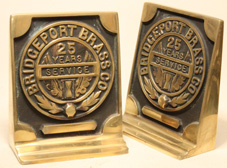
4761 A pair of bookends specially cast by Bridgeport Brass Co for presentation to employees completing 25 Years Service. The symbolic part of the design includes an hour glass between a pair of wings, illustrating well how time flies when working for a good employer. The bookends have a tapered design that makes them ideal for their purpose in addition to being easy to strip from a mould. Each has a cartouche for the name of the recipient, blank for this pair so perhaps they are from old, non-presented stock. The surface finish is excellent. For this short run of high quality production the use of ‘permanent’ metal moulds and the gravity die casting method would have been ideal. Underneath each end is a slight depression caused by metal contracting on solidification and showing that they were cast, as to be expected, upside down. Each has a height of about 150mm (6") but the weights are slightly different at 1,655 and 1,685g (3lb 10½ oz and 3lb 11½ oz) which is not surprising.
The company was incorporated in 1865 in Bridgeport, Conn., USA to make clock movements and expanded to cast, roll and draw their own copper and brass and manufacture copper- and brass-wares including 'Rochester' oil lamps, burners, electric lamps, fasteners and similar items with a labour force of up to 800. They adopted the motto 'From ingot to finished product'. They were bought out by Olin Brass of East Alton, Illinois, USA and the site closed in 1983. Barnum Museum.
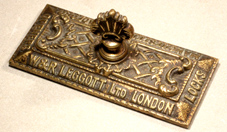
6662 Well decorated conventional Victorian desk paperweight by W. R. Leggott of Bradford, Leeds, Manchester and London, brassfounders and fabricators, makers of locks and openers. Length 110mm (4¼").
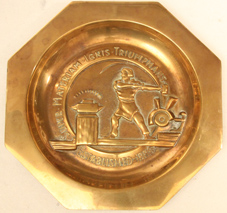
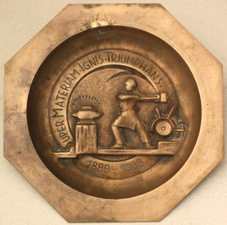
731 & 2791 One of these well-cast hexagonal brass ashtrays has a sharply-defined design that shows a blacksmith swinging his hammer towards an anvil on which is a workpiece that is shown as red hot by the radiation over it. To right seems to be a cut-off saw. Underneath is the legend ‘Established 1888’ and over it ‘Super Materiam Ignis Triumphans’ which can perhaps be translated as ‘Fire succeeds over material’. The underside shows a die-cast finish with raised lettering ‘Made in England’. Another version is also approximately 160mm (6¼”) across flats and has a similar but less well defined design but with ‘1888-1938’ in the exergue instead. The appearance of the underside of this one confirms that this item was cast in sand instead of die-cast and is unexpectedly marked ‘Made in Holland’ rather than England. There is no company name evident on either item but the theme is obviously metallurgical. 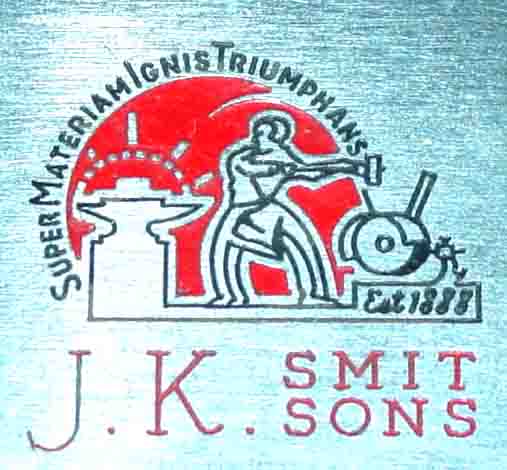 From a similar design eventually found on a ‘Zippo’ lighter it became apparent that this design of souvenir came not from a brassfoundry was made for distribution by J. K. Smit and Sons who still specialise in providing industrial diamonds and diamond tipped cutting tools. They had and still have premises in Amsterdam, London and New York.
From a similar design eventually found on a ‘Zippo’ lighter it became apparent that this design of souvenir came not from a brassfoundry was made for distribution by J. K. Smit and Sons who still specialise in providing industrial diamonds and diamond tipped cutting tools. They had and still have premises in Amsterdam, London and New York.
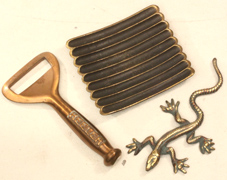
1175 999 3221 A promotional ash tray in the late Hagenauer style of Walter Bosse but made in USA by the Keeler Brass Co., Middleville, Mich. It is rectangular, 95 x 83 mm and sits nicely on four cast feet with a weight of 190g. Other promotional items that they made included a detailed lizard and a bottle opener. All are well marked with the company name.
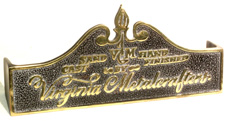
5030 and 1970 Virginia Metalcrafters Advertising Display polished letters which read: "Sand Cast, Hand Finished by Virginia Metalcrafters" It measures approximately 200mm (8") long.
Also Cast brass ashtray, a souvenir from the historical re-creation of the town of Colonial Williamsburg in Virginia having the 'Governors’ Palace' in the centre.
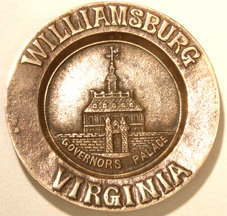 The excellent quality sand casting is unfettled and has a good finish on the top face but the underside is fully machined and stamped 'Korea'. Diameter 115mm (4 1/2"), weight 160g.
The excellent quality sand casting is unfettled and has a good finish on the top face but the underside is fully machined and stamped 'Korea'. Diameter 115mm (4 1/2"), weight 160g.
The historic district of Colonial Williamsburg includes many of the buildings from 1699 to 1780 that formed the capital of the State of Virginia. It has the excellent motto ‘that the future may learn from the past’. Part of the merchandising policy is the sale of museum-quality reproductions including domestic brassware. Originally these were locally sourced but are now procured according to requirements.
1175 999 3221 A promotional ash tray in the late Hagenauer style of Walter Bosse but made in USA by the Keeler Brass Co., Middleville, Mich. It is rectangular, 95 x 83 mm and sits nicely on four cast feet with a weight of 190g. Other promotional items that they made included a detailed lizard and a bottle opener. All are well marked with the company name.
6891 A promotional cast brass trinket tray with a harvest wheat theme in the form of a basket with handles and stalks of wheat. The surface detail and quality is excellent and the size 131x 105mm, it stands on three legs and weighs a reasonable 270g (9½ oz). The underside has cast-in wording 'With the compliments of E.J. Smith & Co., Tyseley Metal Works, Birmingham. (Check - Edwin Smith, 2, Heneage Street in 1903, Birmingham city centre, not present by 1946).
7852 The brass foundry scene on this souvenir belt buckle was designed and produced around 1980. It is marked on the rear by Anacortes Brass Works Foundry 2000 R Ave., Anacortes, WA 98221, United States.
After